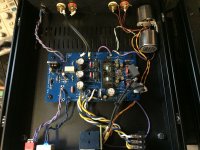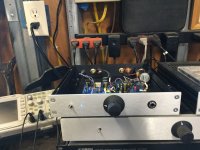Recommended NuHybrid Headphone Amp Mods
After building and listening to the Nelson Pass B1 Korg preamp and comparing it to the Pete Millett NuHybrid Headphone amp as well as Pete's Nutube Buffer, I like Papa's Korg tube setup a bit better than Pete's. So here is what I did to modify the NuHybrid Headphone amp to have it sound more like the B1 Korg. This build was done in a DIYaudio Galaxy chassis with all jacks, power switch, LED and volume pot all mounted off the PCB and on the chassis panels.
1. Since the triode circuit inverts the signal polarity and it is difficult to reverse the headphone transducer connections which would require taking the headphones apart, I added Jensen JT-11P-1 1:1 line input transformers with the primary winding connections reversed. Best USA price I found was Markertek at $63 each including shipping. I first tried some inexpensive Triad TY-250P transformers but their lack of shielding, excessive phase shift in the low bass and higher THD proved unacceptable. The Jensen inputs were connected to isolated RCA input jacks. The outputs directly to the volume pot. The can and electrostatic shield connections were connected to the right input jack ground/mounting PCB location. Not shown in the photos, I later lifted the direct chassis ground connection at that point and added the series resistor/cap to chassis ground connection shown in the data sheet. A dedicated ground wire was run from the volume pot to the left input jack ground/mounting PCB location. Since I was using a 10K pot, the recommended damping network was not required. Even though the pot is an Alps RK27, it has excessive noise at the extreme CCW rotation, which seems to be a problem with 10K pots in general. If I change it to something like a 50K, I'll add the damping network shown in the Jensen data sheet.
2. I bypassed the on board PCB volume pot connections altogether and went straight from the pot to some upsized Kemet 220 nF input caps at C20 and C21. One side of each cap is hanging off the edge of the board. Shielded connection from the pot to the cap is grounded only at the pot end, although best practice would typically reverse that scheme.
3. I changed the voltage divider resistors R19, R20, R22, R23 from 475K to 332K.
4. I changed the plate resistors R13, R14 from 475K to 332K.
5. I set the plate voltage at TP1 and TP2 to somewhere around +9.7 volts. I found this is best adjusted while listening to music and set to your preference. I also found that anything over +10.5 volts made the magic go away.
So how does it sound? With the resistor and plate voltage mods, it sounded better than stock. Much smoother with no loss of dynamics. Correcting the signal polarity with the transformers made a significant improvement in detail and imaging. Yes, they cost as much as the PCB, tube and board components combined but once you hear the difference, there is no going back.
After building and listening to the Nelson Pass B1 Korg preamp and comparing it to the Pete Millett NuHybrid Headphone amp as well as Pete's Nutube Buffer, I like Papa's Korg tube setup a bit better than Pete's. So here is what I did to modify the NuHybrid Headphone amp to have it sound more like the B1 Korg. This build was done in a DIYaudio Galaxy chassis with all jacks, power switch, LED and volume pot all mounted off the PCB and on the chassis panels.
1. Since the triode circuit inverts the signal polarity and it is difficult to reverse the headphone transducer connections which would require taking the headphones apart, I added Jensen JT-11P-1 1:1 line input transformers with the primary winding connections reversed. Best USA price I found was Markertek at $63 each including shipping. I first tried some inexpensive Triad TY-250P transformers but their lack of shielding, excessive phase shift in the low bass and higher THD proved unacceptable. The Jensen inputs were connected to isolated RCA input jacks. The outputs directly to the volume pot. The can and electrostatic shield connections were connected to the right input jack ground/mounting PCB location. Not shown in the photos, I later lifted the direct chassis ground connection at that point and added the series resistor/cap to chassis ground connection shown in the data sheet. A dedicated ground wire was run from the volume pot to the left input jack ground/mounting PCB location. Since I was using a 10K pot, the recommended damping network was not required. Even though the pot is an Alps RK27, it has excessive noise at the extreme CCW rotation, which seems to be a problem with 10K pots in general. If I change it to something like a 50K, I'll add the damping network shown in the Jensen data sheet.
2. I bypassed the on board PCB volume pot connections altogether and went straight from the pot to some upsized Kemet 220 nF input caps at C20 and C21. One side of each cap is hanging off the edge of the board. Shielded connection from the pot to the cap is grounded only at the pot end, although best practice would typically reverse that scheme.
3. I changed the voltage divider resistors R19, R20, R22, R23 from 475K to 332K.
4. I changed the plate resistors R13, R14 from 475K to 332K.
5. I set the plate voltage at TP1 and TP2 to somewhere around +9.7 volts. I found this is best adjusted while listening to music and set to your preference. I also found that anything over +10.5 volts made the magic go away.
So how does it sound? With the resistor and plate voltage mods, it sounded better than stock. Much smoother with no loss of dynamics. Correcting the signal polarity with the transformers made a significant improvement in detail and imaging. Yes, they cost as much as the PCB, tube and board components combined but once you hear the difference, there is no going back.
Attachments
Great idea. I did consider a transformer to “correct” the polarity of my B-1 Korg NuTube also.
But that part of my implementation is on hold. Great to see someone has done it.
But that part of my implementation is on hold. Great to see someone has done it.
Nice! I also consider using transformer to get polarity back, only I was thinking on using top line Jensen output transformer that I have around
That means it could be an idea to reverse polarity on balanced input for my Aleph 1.7 "Buffer" after the Korg. Or at the output.
Nice! I also consider using transformer to get polarity back, only I was thinking on using top line Jensen output transformer that I have around
I think output transformers are almost half the cost of equivalent performance input transformers and are therefore a good option for a preamp. However, they are harder to find in general distribution than the inputs. You have to buy direct from the manufacturer, pay full price plus shipping.
But for a headphone amp, I wanted to keep the low output impedance of the opamp driver connections and opted for the shielded input transformers.
I think output transformers are almost half the cost of equivalent performance input transformers and are therefore a good option for a preamp. However, they are harder to find in general distribution than the inputs. You have to buy direct from the manufacturer, pay full price plus shipping.
But for a headphone amp, I wanted to keep the low output impedance of the opamp driver connections and opted for the shielded input transformers.
I'm not sure how's the quality performance ratio in this specific circuit but the Jensen JT-11-BMCF are over 200$ a pair.
I'm not sure how's the quality performance ratio in this specific circuit but the Jensen JT-11-BMCF are over 200$ a pair.
Not sure the Jfet output buffers could take advantage of the +27dBu this transformer is rated to do. It is definitely Jensen's top of the line output unit. When I said half the cost, was thinking of the J-11-FLCF, a +21dBu transformer. That is the pigtail version of the transformer Papa used in the F6 power amplifier design.
Are the Jensens specifically for the headphone amp? I am thinking of putting them in for the preamp.
Are the Jensens specifically for the headphone amp? I am thinking of putting them in for the preamp.
They were a necessity for the headphone amp (I my estimation). I really don't see the necessity for the B1 Korg preamp, unless you want to try driving high impedance headphones directly or if you have some situation where reversing the loudspeaker lines is problematic.
They were a necessity for the headphone amp (I my estimation). I really don't see the necessity for the B1 Korg preamp, unless you want to try driving high impedance headphones directly or if you have some situation where reversing the loudspeaker lines is problematic.
Definitely not a necessity and I'm more concerned it can potentially induce some problems... If I didn't have those at hand I would more gladly invest 200$ in good film caps on signal path.
Definitely not a necessity and I'm more concerned it can potentially induce some problems... If I didn't have those at hand I would more gladly invest 200$ in good film caps on signal path.
Since the transformers have pigtail leads, seems simple enough to temporarily wire some plugs on the primaries and jacks on the secondaries and just plug them into the B1 Korg outputs and have a listen. Probably best to reverse polarity on the primary leads and don't forget to return the loudspeaker leads to normal. Perhaps not a totally true test since putting them inside of a chassis would theoretically provide an additional bit of shielding but should be very, very close.
@Fabian 85:
Coolest enclosure EVER! I especially like your invisible volume-knob!
I dare not even think about how expensive that must have been. 😀
Coolest enclosure EVER! I especially like your invisible volume-knob!
I dare not even think about how expensive that must have been. 😀
Thats the DIY spirit! Get it running and debugged, then put it in a pretty chassis.
There need to be more wooden boards, cake pans and cardboard boxes. I love it!
There need to be more wooden boards, cake pans and cardboard boxes. I love it!
Thanks guys... haven't thought about a final enclosure yet... but as I need it to be carried over to a friend in a few weeks I had to make this pro enclosure to get the precious preamp protected! Needless to say, that it has not that much of a high WAF! ;-)
With that setup, I might recommend isolating the B1 Korg PCB ground from the chassis using insulating mounting hardware. Then make a single 10 Ohm connection from the audio ground to the PSU ground. Also make sure your input RCAs are not connected to chassis ground, only to the B1 Korg audio ground.
- Home
- Amplifiers
- Pass Labs
- B1 with Korg Triode






